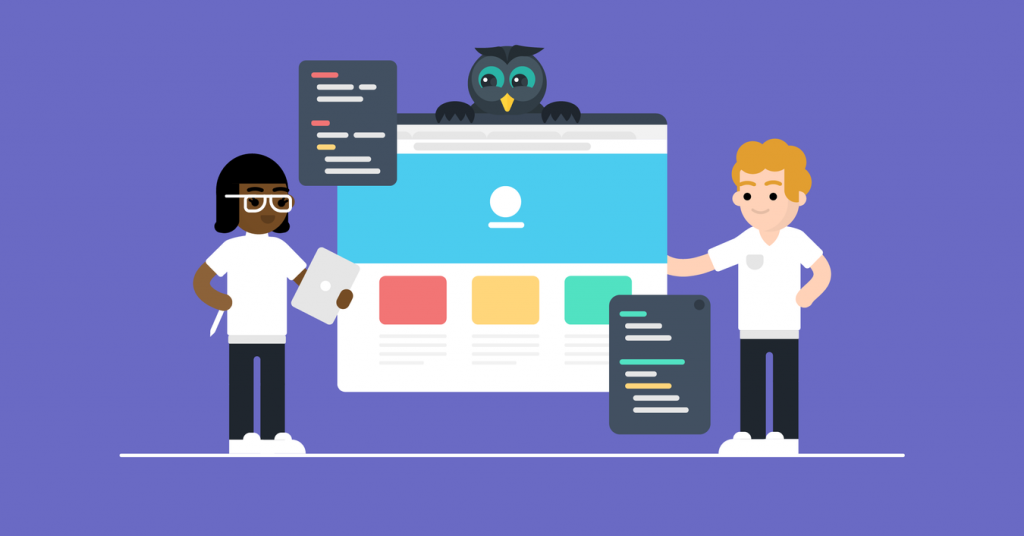Since the booming of the Internet at the end of the 20th century, we all have witnessed a resulting rise in websites. According to the U.S. Bureau of Labor Statistics (BLS), the projected growth rate for web developers in the U.S. from 2022 to 2032 is 16%, much faster than the average for all occupations. Furthermore, the global developer population is expected to reach 28.7 million people by 2024, an increase of 3.2 million from the number seen in 2020. This indicates that web development is becoming a promising and sought-after job in the market.
You may think of becoming a web developer and plan to learn one or two coding languages. However, do you ensure that you fully understand what a web developer does? This article will detail the main role of web developers and provide a comprehensive guide to starting this career path. Let’s find out in this article with Designveloper.

What Is a Web Developer?
Web developers are programmers who engage in the development of websites and web applications by using programming languages such as JavaScript, Java, PHP, or Python that make sites operate properly. They build websites that not only satisfy the demands of end-users but also enable them to be attracted and navigate easily. Companies now can employ either full-time, part-time, or freelance web developers for different projects.

When web developers perform behind-the-scenes activities that particularly focus on web servers to deliver database information to browsers, they are called back-end developers. Meanwhile, front-end web developers work in browsers and identify what end users will see in the interface part. Besides, those working on both client and server sides are known as full-stack web developers.
What Does a Web Developer Do?
Going further into what a web developer exactly does, you’ll find out his or her main duties and daily routines. However, the roles of web developers may vary in the different companies they work on. Today’s post will list the main and daily responsibilities you’ll take, regardless of your web developer job.
1. Main Responsibilities
- For back-end web developer: Use back-end server languages (e.g. PHP, Python, Ruby, or Java) to construct databases and design the architecture of websites or web applications;
- For front-end web developers: Use front-end Javascript frameworks and libraries (e.g. Vue.js, React Native, Backbone.js, or Angular) to add functionality to sites and design smooth UIs;
- Meanwhile, a full-stack web developer is liable for those tasks above;
- Fix bugs and issues regarding the performance of websites or web applications;
- Peer view a development team’s work and deliver prompt feedback to guarantee the code’s cleanliness.
- Develop Application Program Interfaces (APIs) to make sure the fluent data exchange between applications;
- Work with different stakeholders to check the project’s progress and add new features to websites (if any) to ensure their performance;
- Perform maintenance and improvement activities to avoid unpleasant user experiences;
- Update new and advanced technologies, frameworks, and trends, then share with colleagues.
2. Daily Tasks
- Receive new projects, analyze client requirements and suggest possible solutions;
- Create parameters for new web applications or websites;
- Cooperate with other development team members such as business analysts, web designers, project managers, and other stakeholders to develop functional websites;
- Test bugs and performance errors;
- Receive feedback from clients and testers, accordingly fix bugs or errors
- Maintain and update websites regularly to improve user experience;
- Proofread coding of coworkers;
Recommended reading: How Much Does Google Pay Their Software Engineers?
3. How Much Does a Web Developer Make?
The salary of a web developer can vary greatly depending on various factors such as location, the company they work for, their technical background, and their level of experience. As of 2024, the average annual pay for web developers in the US is $81,957, according to Glassdoor. This figure includes a base salary of $77,367 and an average additional yearly pay of $4,589. Additional pay insights can include commissions, bonuses, and profit-sharing.
The US Bureau of Labor Statistics (BLS) projects 23 percent job growth for web developers and digital designers through 2031. This dynamic career may help you determine if a web development career is the right path for you.

Even a freelance web developer in the U.S. can have an average earning of $75,430. However, beginners without an impressive web developer portfolio or enough experience may struggle to find a well-paid project.
Recommended reading: Web Developer Salaries in Vietnam 2022
How to Become a Web Developer?
Similar to other occupations, those who wish to become skilled web developer need to devise a detailed plan in pursuit of this career, ranging from choosing their favorite programming languages, and preparing for essential qualifications and skills to identifying when they can complete a course and seek a job. Here are four fundamental steps you should follow to become a web developer in the future:
Determine What Kind of Web Developer You Prefer
Which web developer jobs are you aiming at? The front end, Back end, or Full stack web developer? Key roles and necessary coding languages for kinds of web developers are rather different. For example, a recruiter who needs a full-stack web developer may require applicants to show their proficiency with both front-end languages such as HTML, CSS, or JavaScript and server-side languages such as Python or Ruby. If you have experience with only client-side technologies, you cannot be chosen for the position. Therefore, you initially should determine which aspect of web development you’re more interested in and good at.
Required Qualifications
Many companies don’t require which qualifications you should have to apply for a web developer position. They value your outstanding knowledge and skills over bachelor’s degrees. Having said that, it doesn’t mean that no web developer certification and qualification are important, especially for freshers.

Accordingly, entry-level web developers should hold at least a bachelor’s degree in Computer Science, Management Information Systems (MIS), or related fields. If you don’t spend much time on tertiary education, you can enroll in short-term courses or boot camps to get some web developer certification.
Soft Skills
Working on computers doesn’t mean you don’t need to communicate with human beings. Therefore, a web developer today is required to have decent soft skills to interact with his/her team members and clients effectively. These skills include:
- Detail-oriented skills;
- Decision-making and problem-solving skills;
- Logical analysis;
- Can work independently and work in groups;
- Ability to multitask – that is, to participate in several projects at the same time;
- Ability to have responsibility and capability for getting projects done on time;
- Communication and negotiation skills to discuss with colleagues, customers, and superiors;
Promote Yourself with Online Portfolios
Saying is much easier than doing. This means you cannot persuade recruiters that you’re an excellent candidate by only showing your academic results. A web developer portfolio is always essential to prove your capabilities. Like a website, it should facilitate navigation and provide sufficient information for companies to know you’re well.
Frequently Asked Questions
1. What is the difference between a web developer and a web designer?
It’s essential to understand the distinction between a web developer and a web designer. These two roles, while closely related, focus on different aspects of website creation.
Web designers are akin to architects. They create the look and feel of a website, focusing on aspects like layout, color schemes, typography, and user interfaces. Their goal is to create aesthetically pleasing and intuitive designs that provide a seamless user experience. They often use tools like Adobe Photoshop and Illustrator to create their designs.
On the other hand, web developers are more like builders. They take the design blueprint provided by the web designer and turn it into a fully functioning website. Web developers write the code that makes the website work. They’re responsible for implementing features, ensuring the site works across different browsers and devices, and optimizing loading speeds.
2. How long does it take to become a web developer?
The time to become a web developer varies based on your chosen education route. Boot camp courses can be completed in as few as three months, providing quick and focused learning. On the other hand, degree programs may take several years for a more comprehensive understanding. For self-learning, the duration is variable and depends on individual commitment and study intensity.
In terms of a career transition into web development, the average time is around a year. While some may transition faster, others may take a bit longer. The key factor influencing success is the effort and commitment put into the learning process.
3. Are web developers in high Demand for 2024?
Definitely yes. According to the U.S. Bureau of Labor Statistics, the demand for web developers and digital designers is expected to soar, with a projected 16% growth from 2022 to 2032. This rate is significantly higher than the average for all occupations, signaling a robust demand for skilled professionals in the field.
Each year, an average of 19,000 job openings for web developers and digital designers are anticipated, reflecting a sustained need for talent in the industry. In the United States alone, web development has provided employment to 197,100 developers, underlining the sector’s substantial contribution to the job market.
Looking ahead, the industry is poised for remarkable growth, with an estimated 23% increase from 2021 to 2031. This growth rate surpasses that of many other occupations, emphasizing the continued high demand for web development expertise.
4. Is it hard to become a web developer?
The journey to becoming a web developer, like any profession, presents its own set of challenges. It requires dedication, time, and effort. However, the complexity of the process can vary depending on the individual’s background, learning style, and the specific area of web development they wish to pursue.
For someone asking “What does a web developer do?”, it’s important to understand that web development encompasses a wide range of skills. This includes front-end development (working with client-side technologies like HTML, CSS, and JavaScript), back-end development (dealing with server-side languages like Python, Ruby, and PHP), and database management. Each of these areas requires a different set of skills and knowledge.
Learning to code is often the first hurdle. It’s a skill that requires practice and patience. However, with the plethora of online resources, coding bootcamps, and degree programs available today, acquiring these skills has become more accessible than ever.
Next comes understanding how different technologies work together to create a functional website or application. This involves learning about servers, databases, APIs, and more. It’s a complex process, but with a structured learning approach, it becomes manageable.
Finally, staying updated with the latest trends and technologies in web development is crucial. The tech world evolves rapidly, and what’s relevant today might not be tomorrow. Hence, continuous learning is a part of a web developer’s journey.
In the end, while the path to becoming a web developer is not without its challenges, it’s certainly achievable with persistence, curiosity, and a willingness to learn. And the reward? A dynamic, creative career with plenty of opportunities for growth.























